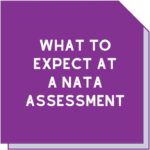Zero Conditions, Zero Drama: How to Nail Your NATA Assessment (Without Losing Your Mind)

Let’s face it—there’s a special kind of tension that only a NATA assessment can inspire.
Even for labs that have been accredited for years, the lead-up to an assessment often involves a flurry of coffee-fuelled document checks, eye-rolls at last year’s findings, and a sense of doom that something will be picked up – again! (Those NATA assessors surely have a quota for these things.) It might be a new interpretation of a clause you thought you’d nailed in 2019, or perhaps a finding that feels more like a philosophical disagreement than an actual non-compliance.
Sound familiar?
If you’ve been through enough assessments to recognise the stages of NATA-induced grief (denial, anger, bargaining, paperwork, acceptance), you’re not alone. But here’s the kicker: you actually can get through a NATA assessment with zero conditions.
Yes, you read that right. Zilch. Nada. The elusive no findings outcome isn’t just for unicorns and ISO fairytales. It’s achievable, and dare we say it, maintainable.
So how do you get there? Pour yourself a cup of strong tea (or something stronger—we’re not judging), and let’s break it down.
Step 1: Stop Waiting Until It’s “Assessment Season”
 Too many labs treat NATA assessments like Christmas: it comes every couple of years, you scramble to get things presentable, and someone inevitably cries.
Too many labs treat NATA assessments like Christmas: it comes every couple of years, you scramble to get things presentable, and someone inevitably cries.
Here’s a wild idea: integrate NATA-readiness into your regular operations. Make compliance part of your everyday lab culture rather than a biennial panic attack. That way, when your assessment rolls around, you’re already prepared. There’s no frantic folder-finding required.
Think of it like brushing your teeth every day instead of getting a root canal every two years.
Environmental Testing Lab – No Conditions After 11 Years of Findings
An environmental testing lab came to us with a history of persistent, low-level findings at every assessment. Nothing show-stopping, just a constant trickle of “minor” issues. We worked with them to develop a monthly internal checklist, integrated training refreshers into toolbox meetings, and introduced a “compliance buddy” system. Result? Their most recent NATA assessment was their first ever with no findings. Cue celebratory morning tea and a sigh of relief from the lab manager.
Step 2: Learn to Love the Standards (Okay, at Least Tolerate Them)
Yes, the standards can feel dry. Yes, they sometimes read like they were written by a committee of sleep-deprived lawyers. But if you’re going to win the NATA game, you need to know the rules.
The biggest trap we see? Labs that interpret the standards based on assumptions rather than actual evidence. “We’ve always done it this way” is not a defence NATA will accept.
Get clear on what the clauses actually say, not what you think they mean. Highlight them, annotate them, start a group chat called “ISO-mates” if that’s what it takes. Knowledge is power, and in this case, it’s the power to shut down unnecessary findings.
Step 3: Ditch the Dodgy Documentation
One of the most common findings? Shoddy or inconsistent documentation.
It doesn’t matter how good your testing is if your documents and records look like they were thrown together during a power outage. From procedures and calibration records to training matrices, clarity, consistency, and control are your best friends.
Calibration Lab – File Fix & Formatting Saves the Day
A calibration lab we worked with was technically excellent but had a documentation system held together with duct tape and good intentions. We rebuilt their document systems and control process, introduced digital templates, and trained the team on version control. We also brought some order to their records system. Their next NATA assessment had not only zero conditions, but the assessor commented that it was one of the “clearest systems they’d seen.” Who says formatting isn’t sexy?
Step 4: Train Like You Mean It
 Another classic finding? Training and competency.
Another classic finding? Training and competency.
It’s not enough to say “Jane’s been doing this for 20 years.” NATA wants objective evidence of competence. That means proper records of training, supervision, and assessment. And yes, refresher training too (even if it’s just people periodically reading procedures as they are updated), to demonstrate monitoring of competence.
Set up a system that tracks this and keeps it up to date. And remember: a well-maintained training matrix is like a forcefield against findings.
Bonus tip: If your matrix involves five different Excel sheets and a whiteboard, it’s time to upgrade. We can help with that.
Step 5: Internal Audits That Don’t Suck
Internal audits should be your early warning system, not a tick-the-box exercise done the night before the real assessment. Cramming was never really the best approach for learning, and it’s also not great for preparation for a NATA assessment.
A solid internal audit:
-
Is planned and risk-based
-
Actually digs into systems, not just surface checks
-
Has corrective actions that are real, not just “noted—will fix someday”
If your audits aren’t finding anything, you’re either perfect (congrats, robot overlord) or you’re not looking hard enough. NATA wants to see that you find and fix things before they do. That’s what competence looks like.
Step 6: Embrace the Corrective Action Mindset
Nobody’s perfect. Even the best labs will occasionally stuff something up. What matters is how you deal with it.
If your non-conformances are met with sighs, shrugs, or “we’ll just write a quick fix and move on,” you’re missing the point. NATA is looking for root cause analysis and effective corrective action.
That means:
-
Actually investigating what went wrong
-
Putting something in place to stop it happening again
-
Following up to make sure it worked
Not just plugging a leak with duct tape.
Step 7: Speak Fluent Assessor
Assessors are people too (really, they are). Most are experienced and knowledgeable—but they’re not mind readers.
If you’ve done something brilliant to improve compliance, show it off. If something looks a bit odd on paper, explain the context. Communication matters.
Think of it like lab speed dating: you’ve got limited time to impress someone who’s judging your systems and asking awkward questions. Don’t leave them guessing.
Lifting Gear Lab – Coaching the Team for Assessment Day
A lifting gear testing lab had all their systems in place, but they still walked away from every assessment with conditions, not due to actual issues, but because assessors couldn’t see the evidence clearly during the visit. The team was nervous, gave short answers, and didn’t always know how to “talk NATA.” We ran a tailored coaching session with their staff to rehearse how to walk through procedures, highlight compliance points, and respond confidently to questions. The result? Their next assessment was not only condition-free, but the lead assessor noted how engaged and clear the team was throughout. No conditions. No drama. Big smiles.
Stop Doing It Alone
Let’s be honest- most lab managers didn’t sign up to become ISO experts, paperwork wranglers, and internal audit ninjas. You’ve already got real work to do.
That’s where we come in.
At MAS Management Systems, we’ve helped dozens of labs go from “yet another finding” to “no conditions—cheers!” We understand the standards, we know the NATA process inside-out, and we actually make compliance make sense.
Whether you need a full system review, help training your team, or just want someone to sanity check your documents, we’re here to help.
Because at the end of the day, you deserve to walk out of your next NATA assessment with zero findings and a giant grin, not a twenty-page list of things to fix.
Need Help Getting to No Conditions?
Let’s talk.
Call or email MAS Management Systems today and find out how we can help you transform your next NATA assessment from stress-fest to success story.
Email info@masmanagementsystems.com.au or phone Maree on 0411 540 709.
Remember, you don’t have to do this alone!
Download this article here




